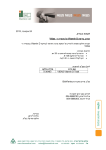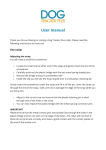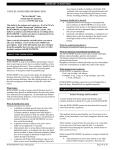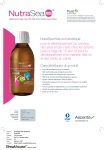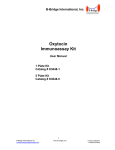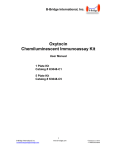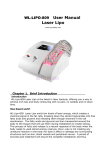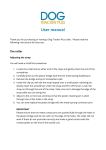Download Thyroxine (T4) ELISA Kit - B
Transcript
B-Bridge International, Inc. Thyroxine (T4) ELISA Kit User Manual Catalog # K3050-1 K3050-5 1 Plate 5 Plates 1 B-Bridge International, Inc. Thyroxine 150414 TABLE OF CONTENTS Intended Use 3 Background 3 Assay Principle 4 Kit Components 4 Materials Required 4 Precautions 5 Reagent Preparation 5 Sample Preparation 6 Assay Protocol 7 Calculations 8 Typical Data 8 Typical Standard Curve 8 2 B-Bridge International, Inc. Thyroxine 150414 INTENDED USE B-Bridge’s Thyroxine (T4) kit is designed to quantitatively measure T4 present in serum, plasma (EDTA and Heparin), urine, extracted dried fecal samples, and tissue culture media. This kit measures total T4 in serum, plasma, and extracted fecal samples. T4 is species independent. BACKGROUND Thyroxine is the main hormone produced by the thyroid gland. The thyroid hormones, triiodothyronine (T3) and thyroxine (T4), are tyrosine-based hormones produced by the thyroid gland that are primarily responsible for regulation of metabolism. Iodine is necessary for the production of T3 and T4. A deficiency of iodine leads to decreased production of T3 and T4, enlarges the thyroid tissue and will cause the disease known as goiter. The major form of thyroid hormone in the blood is thyroxine (T4), which has a longer half-life than T3. The ratio of T4 to T3 released into the blood is roughly 20 to 1. T4 is converted to the active T3 (three to four times more potent than T4) within cells by deiodinases (5’-iodinase). These are further processed by decarboxylation and deiodination to produce iodothyronamine (T1a) and thyronamine (T0a). All three isoforms of the deiodinases are selenium-containing enzymes, thus dietary selenium is essential for T3 production. Hypothyroidism is the condition that results from under-production of thyroxine by the thyroid gland either because the gland is naturally underactive or because radioiodine therapy or surgery for an overactive gland has resulted in under activity. Thyroxine is taken to replace the deficiency which exists in such situations and therefore to restore normal metabolic activity. Thyroid hormone production is regulated via pituitary thyrotropin (TSH) modulation of thyroxine (T4) prohormone secretion by the thyroid gland and regulation of active triiodothyronine (T3) production in peripheral tissues via metabolic events influencing enzyme. 3 B-Bridge International, Inc. Thyroxine 150414 ASSAY PRINCIPLE The kit offers 2 standard curve ranges. For serum and plasma samples, we recommend using 10 µL of standards or samples. The assay concentration range for T4 will be from 50 ng/ml to 0.781 ng/ml. For urine samples, we recommend alternatively using 100 µL of standards or samples concentrations of T4 that range from 4 ng/ml to 0.0625 ng/ml. A T4 stock solution is provided to generate standard curves for the assay and all samples should be read off the standard curve. Standards or diluted samples are pipetted into a clear microtiter plate coated with an antibody to capture mouse antibodies. A T4-peroxidase conjugate is added to the standards and samples in the wells. The binding reaction is initiated by the addition of a monoclonal antibody to T4 to each well. After an hour incubation the plate is washed and substrate is added. The substrate reacts with the bound T4-peroxidase conjugate. After a short incubation, the reaction is stopped and the intensity of the generated color is detected in a microtiter plate reader capable of measuring 450nm wavelength. The concentration of the T4 in the sample is calculated, after making suitable correction for the dilution of the sample, using software available with most plate readers. KIT COMPONENTS K3050-1 1 plate K3050-5 5 plates Thyroxine (T4) Standard (1,000 ng/ml) in stabilizing solution 40 µl 200 µl Thyroxine (T4) Antibody Mouse monoclonal antibody specific for thyroxine 3 ml 13 ml Thyroxine (T4) Conjugate Thyroxine –peroxidase conjugate in stabilizing solution 3 ml 13 ml 5x Assay Buffer 28 ml 55 ml Dissociation Reagent For use with only serum or plasma samples 1 ml 5 ml 20x Wash Buffer 30 ml 125 ml TMB Substrate 11 ml 55 ml Stop Solution 1M hydrochloric acid solution 5 ml 25 ml Plate sealer 1 each 5 each Clear 96 well Plate Coated with goat anti-mouse IgG Store above components at 4°C MATERIALS REQUIRED BUT NOT SUPPLIED Distilled or deionized water Colorimetric 96-well microplate reader capable of reading OD at 450 nm Software for converting raw relative optical density readings from the plate reader and carrying out four parameter logistic curve (4PLC) fitting. Repeater or multi-channel pipet Timer Additional materials needed for fecal samples – ACS grade ethanol or ethyl acetate, glass test tubes, shaker, speedvac, centrifuge 4 B-Bridge International, Inc. Thyroxine 150414 PRECAUTIONS As with all such products, this kit should only be used by qualified personnel who have had laboratory safety instruction. The complete insert should be read and understood before attempting to use the product. The antibody coated plate needs to be stored desiccated. The silica gel pack included in the foil ziploc bag will keep the plate dry. The silica gel pack will turn from blue to pink if the ziploc has not been closed properly. This kit utilizes a peroxidase-based readout system. Buffers, including other manufacturers Wash Buffers, containing sodium azide will inhibit color production from the enzyme. Make sure all buffers used for samples are azide free. Ensure that any plate washing system is rinsed well with deionized water prior to using the supplied Wash Buffer. The Stop Solution is acid. The solution should not come in contact with skin or eyes. Take appropriate precautions when handling this reagent. In all cases, please consult your institution’s safety procedures for working with hazardous chemicals. REAGENT PREPARATION Allow the kit reagents to come to room temperature for 30 minutes. Standards should be run in duplicate for accurate determination of T4 concentrations. Assay Buffer Dilute the 5x Assay Buffer 1:5 by adding 1 part buffer with 4 parts deionized water. The 1x Assay Buffer is stable for 3 months at 4°C. Wash Buffer Dilute the 20x Wash Buffer 1:20 by adding 1 part buffer with 19 parts deionized water. The 1x Wash Buffer is stable for 3 months at room temperature. Standard Preparation - 10 µl format for serum and plasma samples Use all Standards within 2 hours of preparation. 1. Label tubes #1 through #7. 2. Pipet 190 μl of 1x Assay Buffer into tube #1 and 100 μl into tubes #2 - #7. 3. The T4 stock solution contains an organic solvent. Prerinse the pipet tip several times to ensure accurate delivery. Add 10 μl of the T41 stock solution to tube #1 and vortex completely. 4. Take 100 μl of the T4 solution in tube #1 and add it to tube #2 and vortex completely. Repeat the serial dilution for tubes #3 - #7. 5. The concentration of T4 in tubes 1 through 7 will be 50, 25, 12.5, 6.25, 3.125, 1.563 and 0.781 ng/ml. 5 B-Bridge International, Inc. Thyroxine 150414 Standard Preparation - 100 µl format for urine samples Use all Standards within 2 hours of preparation. 1. Label tubes #1 through #7. 2. Pipet 996 μl of 1x Assay Buffer into tube #1 and 300 μl into tubes #2 - #7. 3. The T4 stock solution contains an organic solvent. Prerinse the pipet tip several times to ensure accurate delivery. Add 4 μl of the T41 stock solution to tube #1 and vortex completely. 4. Take 300 μl of the T4 solution in tube #1 and add it to tube #2 and vortex completely. Repeat the serial dilution for tubes #3 - #7. 5. The concentration of T4 in tubes 1 through 7 will be 4,000, 2,000, 1,000, 500, 250, 125 and 62.5 pg/ml. SAMPLE PREPARATION Samples should be run in duplicate for accurate measurements. Ensure that all samples have reached room temperature and have been diluted appropriately prior to running the assay. Samples containing visible particulates should be centrifuge prior to use. Moderate to severely hemolyzed samples should not be used in this kit. Serum and Plasma Samples (10 µl format) Serum and plasma samples need to be treated with the supplied Dissociation Reagent. Addition of this reagent will yield the total thyroxine concentration in serum or plasma. Dissociation Reagent is to be used only with Serum and Plasma samples. Allow the Dissociation Reagent to warm completely to Room Temperature before use. 1. We suggest pipetting 5 µl of Dissociation Reagent into 1 ml Eppendorf tubes. 2. Add 5 µl of serum or plasma to the Dissociation Reagent in the tube, vortex gently 3. Incubate at room temperature for 5 minutes or longer. 4. Dilute with 90 µl of 1x Assay Buffer. This 1:20 dilution can be diluted further with Assay Buffer. Final serum and plasma dilutions should be ≥ 1:20 . Urine Samples (100 µl format) Urine samples should be diluted at least 1:4 with the provided Assay Buffer. Dried Fecal Samples Ensure that the sample is completely dry and powder the sample to improve extraction efficiency. Remove any large particles, such as grass, if possible. We suggest checking the efficiency of extraction by preparing a T4 solution of known concentration in the 1x Assay Buffer. Spike one aliquot of your sample with a volume of the T4 solution in 1x Assay Buffer (Control Spike) and one aliquot of sample with the same volume of only 6 B-Bridge International, Inc. Thyroxine 150414 1x Assay Buffer (Control Sample). Extract samples and both Controls with Ethanol or Ethyl Acetate as described below. 1. Weigh out ≥ 0.2 gm of dried fecal solid into a tube. 2. 3. Add 1 ml of Ethanol (or Ethyl Acetate) for every 0.1 gm of solid. Shake vigorously for at least 30 minutes. 4. Centrifuge samples at 5,000 rpm for 15 minutes. Transfer measured volume of supernatant to a clean tube for evaporation. 5. Evaporate supernatant solution to dryness in a SpeedVac or under nitrogen. Keep dried extracted samples frozen < -20°C in a desiccator. 6. Dissolve extracted sample with 100µl ethanol, followed by at least 400µL 1x Assay Buffer. Vortex well and allow to sit 5 minutes at room temperature. Vortex and sit for 5 minutes twice more to ensure complete T4 solubility. For immunoassays ethanol content in the well should be below 5%. Dilute the ethanol:Assay Buffer mixture ≥ 1:10 with 1x Assay Buffer. 7. Run reconstituted diluted samples in assay immediately according to insert directions. 8. Determine the extraction efficiency by comparing the concentration of the T4 measured in the extracted Control (Control Spike - Control Sample) with the concentration of T4 before extraction. Note: In step 5 if only a portion of the organic solvent is being evaporated, ensure final amounts of measured T4 per gm solid accounts for volume of solution evaporated. Tissue Culture Media (TCM) Samples For measuring thyroxine in tissue culture media (TCM), samples should be read off a standard curve generated in TCM. Samples may need to be diluted further in TCM. The assay was validated using RPMI-1640. Use all samples within 2 hours of preparation or stored at -20°C or colder until assaying. ASSAY PROTOCOL – 10 µL AND 100 µL Standards and samples should be run in duplicate 1. Pipet 10 µl (100 µl for alternate format) of samples or standards into wells in the plate. 2. Pipet 35 µl (125 µl for alternate format) of 1x Assay Buffer into the non-specific binding (NSB) wells. 3. Pipet 10 µl (100 µl for alternate format) of 1x Assay Buffer into wells to act as maximum binding wells (B0 or 0 ng/ml). 4. Add 25 µl of the Thyroxine Conjugate to each well using a repeater pipet. 5. Add 25 µl of the Thyroxine Antibody to each well, except the NSB wells, using a repeater pipet. 6. Gently tap the sides of the plate to ensure adequate mixing of the reagents. Cover the plate with the plate sealer and shake at room temperature for 1 hour. If the plate is not shaken signals bound will be approximately 40% lower. 7. Aspirate the plate and wash each well 4 times with 300 µl 1x Wash Buffer. Tap the plate dry on clean absorbent towels. 8. Add 100 µl of the TMB Substrate to each well, using a repeater pipet. 9. Incubate the plate at room temperature for 30 minutes without shaking. 10. Add 50 µl of the Stop Solution to each well, using a repeater or a multichannel pipet. 7 B-Bridge International, Inc. Thyroxine 150414 11. Read the optical density generated from each well in a plate reader capable of reading at 450 nm. 12. Use the plate reader’s built-in 4PLC software capabilities to calculate Thyroxine concentration for each sample. CALCULATIONS Average the duplicate OD readings for each standard and sample. Create a standard curve by reducing the data using the 4PLC fitting routine on the plate reader, after subtracting the mean OD’s for the NSB. The sample concentrations obtained, calculated from the %B/B0 curve, should be multiplied by the dilution factor to obtain neat sample values. Typical Data Always run your own standard curve for calculating results. Do not use this data. Conversion Factor: 77.7 ng/ml of thyroxine in equivalent to 100 nM 8 B-Bridge International, Inc. Thyroxine 150414 TYPICAL STANDARD CURVE Standard curves vary with each assay. Always run your own standard curves for calculation of results; do not use this data 9 B-Bridge International, Inc. Thyroxine 150414









